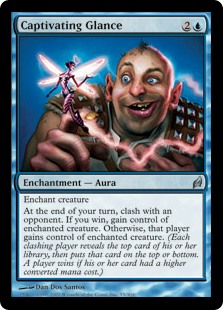With Nationals approaching and since it’s likely very few of them will use stamped product, here is a procedure I’ve already successfully tried a few years ago at a Grand Prix whose stamped product was not be delivered on time.

Why are we usually using stamped product?
Stamped product allows each and every player to verify with a quick glance that the card their opponent is playing belongs to this draft.
This is a good start since, at the very least, it prevents players from bringing their own deck. But this isn’t perfect security: For instance, two players may still exchange some of their picks: These cards would be stamped so that is impossible for the opponent to catch. That’s why deck checks remain a crucial element of tournaments using stamped product.
At Sealed Grand Prix or PPTQs, a player’s card pool is registered by the person in front of them. We reinforce security by making players open and present the content of their boosters to another player.
The main tool to enhance security is to have another individual register a player’s card pool.
This is what we are going to do for a draft as well.
Usually, we swap pools. However, a core component of a draft is the secrecy of the decks, and therefore it must be preserved. Indeed, remembering which cards you passed during a draft is a skill that can give a player an advantage.
Therefore, having drafts pools registered by another player in the pod or when another player from the pod is around is not a solution.
More on security
The intuitive conclusion of the latter point is that the drafts pools should be registered at the construction table. Yet, that causes issues since players would have quite a big opportunity to swap some cards when moving from their draft pod to that construction table.
Players therefore cannot move with their draft pools.
Since you do not want players to move with their decks, you either need to move the draft pools or move the players.
Moving the draft pools is very risky since:
- It requires a lot of manpower or it will be very slow.
- There can be manipulation errors which would be at least very hard to repair:
- A judge or staff member accidentally drops a pool and reveals it.
Note: this risk can be mitigated by having players place their pools in a transparent ziplock bag. - Players swap two pools when passing them to another player.
- A judge or staff member accidentally drops a pool and reveals it.
Since pools cannot move, players will be the ones needing to.
The procedure
- Distribute decklists to each player.
- Ask players to take one and write ONLY their DCI number on the decklist (player using the deck)
Without a name, identifying the owner of a pool is slightly harder (although not impossible, but nothing is perfect) - Instruct players to put their draft pool in a single pile on top of the decklist.
If plastic bags are available, instruct them to place everything inside it. - Instruct players to swap with the player sitting at the pod behind them (see below)
If your tournament is huge, you may want to make players swap by smaller groups so judges can more efficiently monitor the area

- Once completed, swap the external rows (see below)

- Once every player swapped, instruct them to:
- Write their name and DCI Number on the decklist (player registering the deck).
- Register the card pool.
- Once every player is finished, perform the swap again to give pools back to their owners.
- Once every player got their pool back, instruct them to report to their construction table.
Note: There might be some pods with a number of players different than 8. These pods will need to be treated manually.
For obvious reasons, players cannot stand up during this process, or there is a risk they could see pools from other players at their pods.
If players need to use the bathroom, handle it just like you would handle a teammate during a Team Event. Make sure they’re going in a direction where they cannot see other pools from their pod and return using a path that keeps draft pools secret.
Kevin Desprez., with contributions from Stefan Ladstätter
